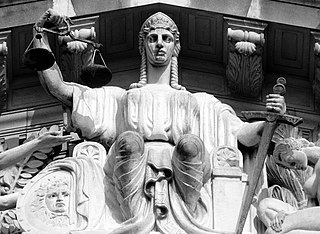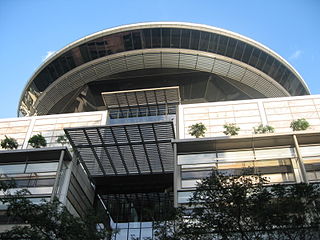
United States appellate procedure involves the rules and regulations for filing appeals in state courts and federal courts. The nature of an appeal can vary greatly depending on the type of case and the rules of the court in the jurisdiction where the case was prosecuted. There are many types of standard of review for appeals, such as de novo and abuse of discretion. However, most appeals begin when a party files a petition for review to a higher court for the purpose of overturning the lower court's decision.
Negligence is a failure to exercise appropriate and/or ethical ruled care expected to be exercised amongst specified circumstances. The area of tort law known as negligence involves harm caused by failing to act as a form of carelessness possibly with extenuating circumstances. The core concept of negligence is that people should exercise reasonable care in their actions, by taking account of the potential harm that they might foreseeably cause to other people or property.
In common law, assault is the tort of acting intentionally, that is with either general or specific intent, causing the reasonable apprehension of an immediate harmful or offensive contact. Assault requires intent, it is considered an intentional tort, as opposed to a tort of negligence. Actual ability to carry out the apprehended contact is not necessary. 'The conduct forbidden by this tort is an act that threatens violence.'
Strickland v. Washington, 466 U.S. 668 (1984), was a landmark Supreme Court case that established the standard for determining when a criminal defendant's Sixth Amendment right to counsel is violated by that counsel's inadequate performance.
In Canadian law, a reasonable apprehension of bias is a legal standard for disqualifying judges and administrative decision-makers for bias. Bias of the decision-maker can be real or merely perceived.

Williams v Natural Life Health Foods Ltd[1998] UKHL 17 is an important English tort law, company law and contract law case. It held that for there to be an effective assumption of responsibility, there must be some direct or indirect conveyance that a director had done so, and that a claimant had relied on the information. Otherwise only a company itself, as a separate legal person, would be liable for negligent information.

Gregg v Scott [2005] UKHL 2 is an English tort law case, on the issue of loss of a chance, in causation. It affirms the principle of Hotson v East Berkshire Area Health Authority, on a narrow margin of 3 to 2. Lord Nicholls' dissent is of particular note, in arguing that loss of a chance should be actionable.
Caperton v. A. T. Massey Coal Co., 556 U.S. 868 (2009), is a case in which the United States Supreme Court held that the Due Process Clause of the Fourteenth Amendment requires a judge to recuse themselves not only when actual bias has been demonstrated or when the judge has an economic interest in the outcome of the case but also when "extreme facts" create a "probability of bias."

Bias is one of the grounds of judicial review in Singapore administrative law which a person can rely upon to challenge the judgment of a court or tribunal, or a public authority's action or decision. There are three forms of bias, namely, actual, imputed and apparent bias.

Procedural impropriety in Singapore administrative law is one of the three broad categories of judicial review, the other two being illegality and irrationality. A public authority commits procedural impropriety if it fails to properly observe either statutory procedural requirements, or common law rules of natural justice and fairness.

Weir-Rodgers v SF Trust Ltd [2005] IESC 2 is a reported decision of the Irish Supreme Court that confirmed that under Section 4 of the Occupiers Liability Act 1995 an occupier of land is not required to take all reasonable care to safeguard the person or property of either trespassers or recreational users.

Tracey, T/A Engineering Design & Management v Burton, [2016] IESC 16, was an Irish Supreme Court case in which the Supreme Court considered the Irish courts' ability to limit the right of access to the courts and, in extreme cases, to dismiss proceedings.

Gilroy v Flynn [2004] IESC 98; [2005] 1 ILRM 290, was an Irish Supreme Court case in which the Court made it clear that excessive delays in the delivery of a statement of claim were unacceptable and could justify dismissing a case. While the Court allowed the appeal against the High Court central to this case to proceed, it effectively reversed the previous "assumption that even grave delay will not lead to the dismissal of an action" even where the fault of the delay lay with a legal adviser rather than the plaintiff.

Chapman v Hearse is a significant case in common law related to duty of care, reasonable foreseeability and novus actus interveniens within the tort of negligence. The case concerned three parties; Chapman who drove negligently, Dr Cherry who assisted him on the side of the road, and Hearse who, in driving negligently, killed Dr Cherry while he was assisting Chapman. In the Supreme Court of South Australia, Hearse was found liable for damages to Dr Cherry's estate under the Wrongs Act 1936. Hearse sought to reclaim damages from Chapman due to his alleged contributory negligence; Chapman was found liable to one quarter of the damages. Chapman appealed the case to the High Court of Australia on August 8, 1961 but it was dismissed as the results of his negligence were deemed reasonably foreseeable. A duty of care was established between Chapman and the deceased and his claim of novus actus interveniens was rejected. Dr Cherry was considered a ‘rescuer’ and his respective rights remained.

Kelly v Trinity College Dublin[2007] IESC 61; [2007] 12 JIC 1411; is an Irish Supreme Court case in which the Court held that former employments or associations are insufficient, in the absence of other evidence, to disqualify a person from participating in disciplinary or similar tribunals related to that former employment.

Bank of Ireland v O'Donnell & ors[2015] IESC 90 is an Irish Supreme Court case that centred around whether the appellants had any right or capacity to bring a motion before the court. They wanted to seek an order of a stay on Mr Justice McGovern's order dated 24 July 2014. In their appeal, they referred to the principle of objective bias and Mr Justice McGovern's refusal to recuse himself. The Supreme Court rejected the application for a stay and held that the law regarding objective bias was clearly stated in the lower court.

Delahunty v Player and Wills (Ireland) Ltd, [2006] 1 IR 304; [2006] IESC 21 was an Irish Supreme Court case in which the Court gave a woman permission to take action for damages against two major tobacco companies in what was the first step in the battle against 'Big tobacco'.

Walsh v Jones Lang Lasalle Ltd [2017] IESC 38, is a decision of the Irish Supreme Court in which the court held that a purchaser bears the risk of reliance on erroneous information unless the vendor has clearly assumed responsibility for its accuracy. In reaching this decision, the court clarified the law in Ireland "in relation to the effect of statements disclaiming liability in actions claiming negligent misstatement."

D.C. v DPP[2005] 4 IR 281, [2006] ILRM 348; [2005] IESC 77 was an Irish Supreme Court case in which the Court confirmed that the standard to be met for prohibiting a trial is "where there is a real or serious risk of an unfair trial".

Persona Digital Telephony Ltd v. Minister for Public Enterprise, Ireland, [2017] IESC 27; was an Irish Supreme Court case in which the Court ruled that third party funding to support a plaintiff's legal costs and disbursements is unlawful.







